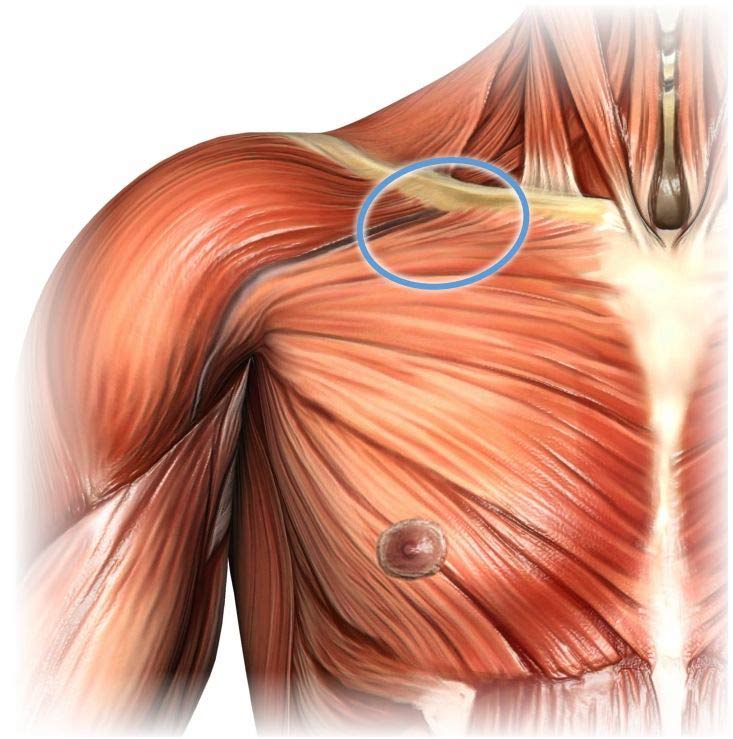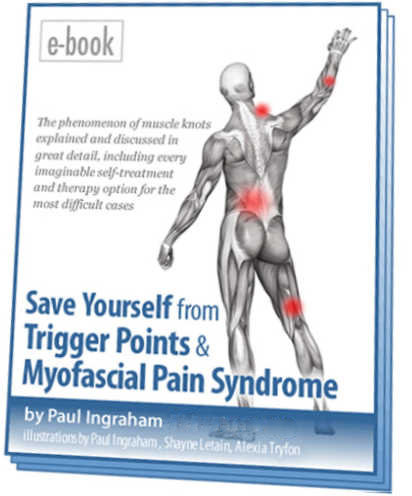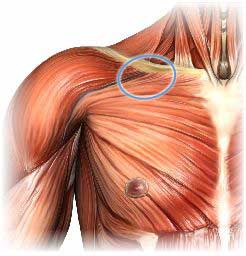Massage Therapy for Your Pectorals
Perfect Spot No. 9, in the pectoralis major muscle of the chest
Trigger points (TrPs), or muscle “knots,” are a common cause of stubborn & strange aches & pains, and yet they are under-diagnosed. The 14 Perfect Spots (jump to list below) are trigger points that are common & yet fairly easy to self-treat with massage — the most satisfying & useful places to apply pressure to muscle. For tough cases, see the advanced trigger point therapy guide.
The “pecs” are popular: of our 700-ish skeletal muscles, the pectoralis major is one of just a dozen or so that most people can name and point to. It also harbours one of the most commonly-encountered and significant trigger points in the human body, and can produce pain much like a heart attack in both quality and intensity. It’s a good target for massage therapy in general, and yet is often ignored.
Pectoralis major basics: the hugging muscle
The pectoralis major covers the top half of your chest. It is mostly an arm mover, although it also stabilizes the joint between your sternum and collar bone. It is the hugging muscle: it powerfully pulls and rotates the arms towards the center of your body.
Like all the big flexors, it’s crazy strong. The pectoralis major is so large that it can always do its job with at least some of its fibers, no matter what position the shoulder is in.
(The pectoralis minor, by the way, is quite a different muscle. As its name suggests, it is much smaller. It is completely covered by the pectoralis major, and does not move the arm at all!)
A manly muscle: the pectoralis gender gap
The pectoralis major is also, interestingly, one of the only muscles in the human body that is almost always much larger in men than it is in women, which accounts for much of the difference in upper body strength between the genders. Even the strongest women usually have relatively thin pectoralis major muscles — something I learned from massaging thousands of people during my massage therapy career.
Regardless, Perfect Spot No. 9 is a good massage location for both men and women.
Where is Perfect Spot No. 9?
Spot No. 9 is easy to find by touch: it’s on the edge of a distinctive pocket or hollow directly underneath your collarbone. The pocket is a small, unmuscled space between the deltoid and the pectoralis major. If you explore right below your collarbone, it is easy to find the soft spot between these two large muscles. Once you’ve found it, press towards the sternum against the edge of the hollow — that’s pectoralis major you’re pressing — and you’ve found Perfect Spot No. 9.

How to massage the pectoralis major
Thumb pressure is often adequate to stimulate Spot No. 9, but many people — especially men, with their larger pectorals — may need knuckles or even an elbow to get a clear “signal.”
Although No. 9 is a specific spot on the edge of the pectoralis major, it’s also quite effective to massage the entire space underneath the clavicle, using the big knuckles. You might need some oil or lotion for this, of course. Another trick is to trap a small ball between the chest and a wall.
Glide or roll towards the centre, catching Spot No. 9 along the way. Try stretching the muscle at the same time, or at least elongating it a bit.
How does Spot No. 9 in the pectoralis major feel?
It feels good, and maybe that’s because the pectoralis major is partly responsible for a common postural bogeymen: the chest “collapsed,” the shoulders rolled forward and inward. Poor posture is largely an over-rated bogeyman,1 much less of a hazard than most people think. But we can certainly still feel stiff, tight, and uncomfortable from this posture — particularly people who routinely work or play with computers (which is almost everyone, these days).
Pressure on Spot No. 9 tends to ease that uncomfortable sense of constriction and stagnancy in the chest, creating a sense of having more space to breathe in. It can be quite pleasant.
Bonus pectoralis major tip: strength training
A lot of men would like to have better developed and well-defined pectoralis major muscles for aesthetic reasons, because “huge pecs” are pretty much the definition of a masculine trait. Unfortunately, a lot of men do not know which exercises will actually get that result.
The confusion arises from the fact that the bottom half of the pectoralis major performs some different functions than the top half. To build up the pectoralis major, you need to exercise the bottom half of the muscle. While all pectoralis major fibres adduct and internally rotate the shoulder, only the lower fibres extend the shoulder. Therefore, the best pectoralis major training exercises include some resistance to shoulder extension. Those exercises are:
- chin ups or front lat (latissimus dorsi) pull-downs with a wide grip2
- a standard bench press or a dumbbell press on a decline bench (that’s with the feet higher than the head)
- barbell pullover, in which you lie on your back, holding a barbell over your head, and then lift it over your face
- cable crossover, in which you pull weighted cables from high and outside towards the center of your body
Note that standard wide-position push ups are a good general pectoralis major exercise, but do not isolate any part of the pectoralis major.
For more general information about training, see Strength Training for Pain & Injury Rehab: Why building muscle is easier, better, and more important than you thought, and its role in recovering from injuries and chronic pain.
About Paul Ingraham

I am a science writer in Vancouver, Canada. I was a Registered Massage Therapist for a decade and the assistant editor of ScienceBasedMedicine.org for several years. I’ve had many injuries as a runner and ultimate player, and I’ve been a chronic pain patient myself since 2015. Full bio. See you on Facebook or Twitter., or subscribe:
Related Reading
- Descriptions of the chest exercises mentioned in the last section, and many more.
Appendix A: Is trigger point therapy too good to be true?
Trigger point therapy isn’t too good to be true: it’s just ordinary good. It can probably relieve some pain cheaply and safely in many cases. Good bang for buck, and little risk. In the world of pain treatments, that’s a good mix.
But pain is difficult and complex, no treatment is perfect, and there is legitimate controversy about the science of trigger points. Their nature remains somewhat puzzling, and the classic image of a tightly “contracted patch” of muscle tissue may well be wrong. What we do know is that people hurt, and it can often be helped.
The Perfect Spots are based on a decade of my own clinical experience as a massage therapist, and years of extensive science journalism on the topic. Want to know more? This is the tip of the iceberg. I’ve written a whole book about it …

Not too good to be true.
Just ordinary good. Trigger point therapy isn’t a miracle cure, but it is a valuable life skill. Practically anyone can benefit at least a little, and many will experience significant relief from stubborn aches and pains. The first few sections are free.
Appendix B: Quick Reference Guide to the Perfect Spots
This index is also available on its own page.
1For headache, neck pain
Under the back of the skull must be the single most pleasing and popular target for massage in the human body. No other patch of muscle gets such rave reviews. It has everything: deeply relaxing and satisfying sensations, and a dramatic therapeutic relevance to one of the most common of all human pains, the common tension headache. And no wonder: without these muscles, your head would fall off. They feel just as important as they are. (Click/tap heading to read more.)
| for pain: almost anywhere in the head, face and neck, but especially the side of the head, behind the ear, the temples and forehead | muscle(s): suboccipital muscles (recti capitis posteriores major and minor, obliqui inferior and superior) |
2For low back pain
This Perfect Spot lives in the “thoracolumbar corner,” a nook between your lowest rib and your spine — right where the stability of the rib cage and thoracic vertebrae gives way to the relative instability of the lumbar spine. It consists of trigger points in the upper-central corner of the quadratus (square) lumborum muscle and in the thick column of muscle that braces the spine, the erector spinae. (Click/tap heading to read more.)
| for pain: anywhere in the low back, tailbone, lower buttock, abdomen, groin, side of the hip | muscle(s): quadratus lumborum, erector spinae |
3For shin splints
Perfect Spot No. 3 is in your shins — seemingly an unlikely place for muscle knots! But there is meat there, and if you’ve ever had shin splints then you know just how vulnerable that meat can be. Even if you’ve never suffered so painfully, your shins probably still suffer in silence — latent trigger points in the upper third of the shin that don’t cause symptoms, but are plenty sensitive if you press on them. (Click/tap heading to read more.)
| for pain: in the shin, top of the foot, and the big toe | muscle(s): tibialis anterior |
4For thoracic outlet syndrome, throat pain and tightness, chest pain
Deep within the Anatomical Bermuda Triangle, a triangular region on the side of the neck, is the cantankerous scalene muscle group. Massage therapists have vanished while working in this mysterious area, never to be seen again. The region and its muscles are complex and peculiar, and many lesser-trained massage therapists have low confidence working with them. (Click/tap heading to read more.)
| for pain: in the upper back (especially inner edge of the shoulder blade), neck, side of the face, upper chest, shoulder, arm, hand | muscle(s): scalenes (anterior, middle, posterior) |
5For carpal tunnel syndrome, tennis elbow
Just beyond your elbow, all the muscles on the back of your forearm converge into a single thick tendon, the common extensor tendon. At the point where the muscles converge, in the muscles that extend the wrist and fingers, lies one of the more inevitable trigger points in the body: Perfect Spot No. 5. It is constantly provoked both by computer usage today, and more often by the use of a pen in simpler times — and by the occasional tennis match, then and now, or maybe crocheting. (Click/tap heading to read more.)
| for pain: in the elbow, arm, wrist, and hand | muscle(s): extensor muscles of the forearm, mobile wad (brachioradialis, extensor carpi radialis longus and brevis), extensor digitorum, extensor carpi ulnaris |
6For gluteal and hip pain, sciatica, bursitis, low back pain
When you have back pain, buttock pain, hip pain, or leg pain, much or even all of your trouble may well be caused by trigger points in the obscure gluteus medius and minimus muscles, a pair of pizza-slice shaped muscles a little forward of your hip pocket. Other muscles in the region are usually involved as well, such as the gluteus maximus, piriformis, and the lumbar paraspinal muscles. However, the gluteus medius and minimus are a bit special: their contribution to pain in this area is particularly significant, and yet people who have buttock and leg pain rarely suspect that much of it is coming from muscle knots so high and far out on the side of the hip. (Click/tap heading to read more.)
| for pain: in the low back, hip, buttocks (especially immediately under the buttocks), side of the thigh, hamstrings | muscle(s): gluteus medius and minimus |
7For jaw pain, bruxism, headache
Your masseter muscle is your primary chewing muscle — not the only one, but the main one — and it covers the sides of the jaw just behind the cheeks. It’s also the main muscle that clenches your jaw and grinds your teeth, unfortunately, and it’s one of the most common locations for trigger points in the human body. It is probably an accomplice in most cases of bruxism (that’s Latin for “grinding your teeth”) and temporomandibular joint syndrome (jaw joint pain), plus other unexplained painful problems in the area. (Click/tap heading to read more.)
| for pain: in the side of the face, jaw, teeth (rarely) | muscle(s): masseter |
8For runner’s knee
A lot of quadriceps aching, stiffness and fatigue emanates from an epicentre of “knotted” muscle in the lower third of the thigh, in the vastus lateralis, a huge muscle — one of your biggest — that dominates the lateral part of the leg. Stretching it is effectively impossible, but massage is an option: although often shockingly sensitive, Perfect Spot No. 8 can also be quite satisfying. It also often complicates or contributes to other problems in the area, especially runner’s knee (iliotibial band syndrome). (Click/tap heading to read more.)
| for pain: in the lower half of the thigh, knee | muscle(s): quadriceps (vastus lateralis, vastus intermedius, vastus medialis, rectus femoris) |
9For chest pain & tightness
The “pecs” are popular: of 700+ muscles, the pectoralis major is one of just a dozen or so that most people can name and point to. It also harbours one of the most commonly-encountered and significant trigger points in the human body, and can produce pain much like a heart attack in both quality and intensity. (Click/tap heading to read more.)
| for pain: anywhere in the chest, upper arm | muscle(s): pectoralis major |
10For plantar fasciitis
The tenth of the Perfect Spots is one of the most popular of the lot, and right under your feet — literally. It lies in the center of the arch muscles of the foot. This is one of the Perfect Spots that everyone knows about. No massage is complete without a foot massage! (Click/tap heading to read more.)
| for pain: in the bottom of the foot | muscle(s): arch muscles |
11For upper back pain
This “spot” is too large to really be called a “spot” — it’s more of an area. The thick columns of muscle beside the spine are often littered with muscle knots from top to bottom. Nevertheless, there is one section of the group where massage is particularly appreciated: from the thick muscle at the base of the neck, down through the region between the shoulder blades, tapering off around their lower tips. There is no doubt that this part of a back massage feels even better than the rest — even the low back, despite its own quite perfect spots, cannot compete. (Click/tap heading to read more.)
| for pain: anywhere in the upper back, mainly between the shoulder blades | muscle(s): erector spinae muscle group |
12For low back and gluteal pain, sciatica
At the top of the buttocks lies a Perfect Spot for massage: a sneaky but trouble-making brute of a trigger point that commonly forms in the roots of the gluteus maximus muscle. It’s below the lowest part of the low back, but it often feels like low back pain. This is the kind of spot that the Perfect Spots series is all about: not only does it tend to produce a profound, sweet ache when massaged, but the extent of the pain that spreads out around it is almost always a surprise. It feels like a key to much more than expected. (Click/tap heading to read more.)
| for pain: in the lower back, buttocks, hip, hamstrings | muscle(s): gluteus maximus |
13For low back pain, sciatica
Some of the Perfect Spots are perfect because they are “surprising” — it’s delightful to find a place to massage that feels highly relevant your pain in an unexpected location. Others are perfect because they are exactly where you expect them to be — and what a relief it is to be able to treat them. Perfect Spot No. 13 is perhaps the ultimate, the quintessential example of a trigger point that is usually “right where I thought the problem was”: in the “pit” of the low back, at the bottom of the thick columns of back muscle beside the spine. (Click/tap heading to read more.)
| for pain: in the low back, buttocks, hamstrings | muscle(s): erector spinae muscle group at L5 |
14For shoulder pain
I avoided adding Spot 14 to this series for many years, because it’s a bit tricky to find. But precision is not required: although there is one specific spot that’s especially good, nearly anywhere under the ridge of bone on the shoulder blade is worthwhile, and often a surprising key to pain and stiffness everywhere else in the shoulder, especially all the way around on the other side, facing forward. (Click/tap heading to read more.)
| for pain: any part of the shoulder, and upper arm | muscle(s): infraspinatus, teres minor |
Notes
- Poor posture is a minor factor in pain and injury, but gets far too much attention in physical therapy and rehab. Many habitual postures are adaptations to anatomical quirks that can’t be changed. Most other “poor posture” is just coping with bad ergonomics. “Posturology” is mostly misguided pseudoscience. When people seem to be vulnerable to postural stresses, the vulnerability is usually the problem. For more information, see Does Posture Matter? A detailed guide to posture and postural correction strategies (especially why none of it matters very much).
- Signorile JF, Zink AJ, Szwed SP. A comparative electromyographical investigation of muscle utilization patterns using various hand positions during the lat pull-down. J Strength Cond Res. 2002;16:539–546. PubMed 12423182 ❐
